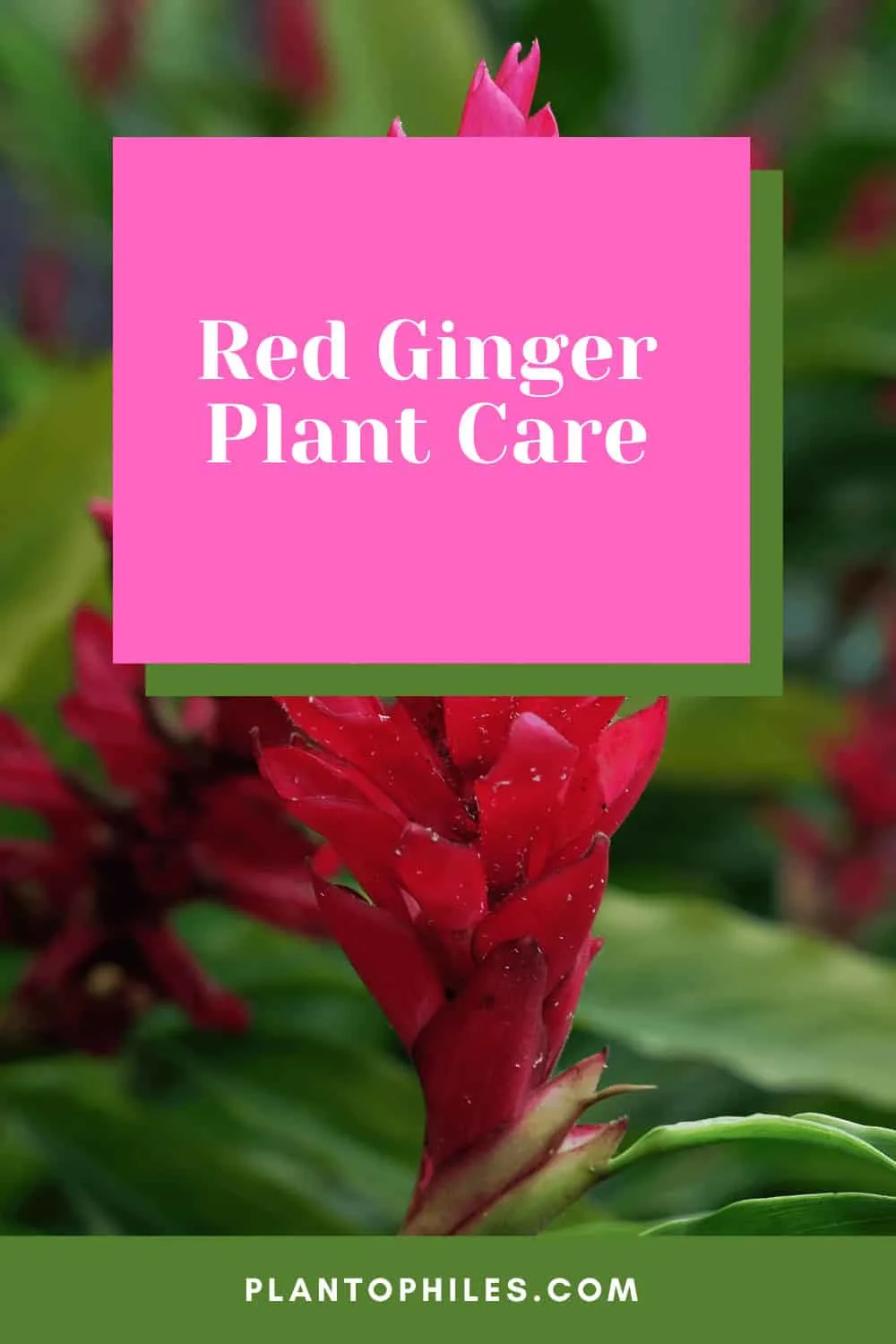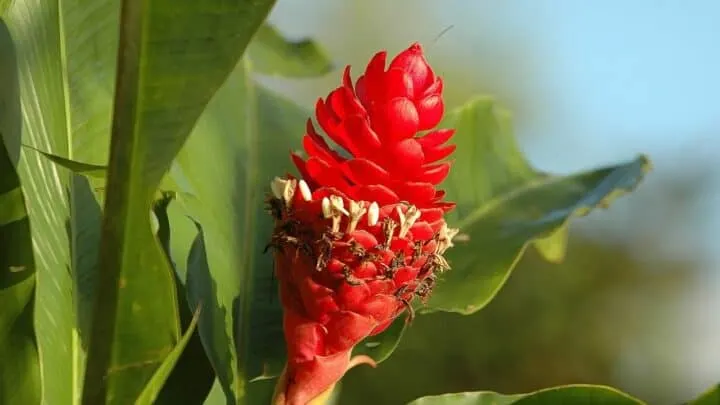Red Ginger plant care. Suppose you are looking for a plant that will give you striking visual aesthetics without being too demanding during its growing period. In that case, the Red Ginger Plant or Alpinia purpurata is the solution you are looking for!
It is not just a refreshing sight but also simple to grow. Even if you are a budding plant parent, you will have no trouble providing the Red Ginger Plant with the minimum care it needs.
This plant, officially called the Alpinia purpurata, is nicknamed “Ostrich Plume” and “Pink Cone Ginger”.
It originates in its striking red bloom, which blossoms out of the bracts stacked together in the plant.
The shoot also grows into stems that bear leaves around the flower. I’m sure you can imagine how beautiful this must look in full bloom!
The Red Ginger Plant is originally indigenous to Malaysia, but that in no way indicates that you can’t have a lovely Red Ginger growing out of a bed in your very own garden!
You need to do the bare minimum for this plant to thrive in your happy place and completely refresh the view of your garden.
Table of Contents
Red Ginger Plant Care
Provide the Red ginger plant with plenty of natural light. Leave it in a spot with direct sunlight in the morning. Provide it with nutrient-rich, well-aerated, and well-draining soil. Only water if the topsoil’s dry. Thrives in temperatures ranging between 65℉ and 75°F (18°C to 24°C).

Red Ginger Plant Care
Soil
The Red Ginger Plant isn’t very sensitive to mild fluctuations in the soil quality it grows. Provide the plant with a soil mix that will be well-draining and sufficiently rich in nutrients, to give your plant maximum support.
The Alpinia purpurata belongs to a tropical climate.
While you don’t necessarily have to emulate the soil type that the plant is used to in its natural habitat, it would be wise to provide it with something that would be somewhat similar.
In this case, the plant is used to growing in soil that will not retain water for a very long time. The soil should have adequate ventilation as well.
Therefore, the kind of soil you want to provide it with should be well-draining.
Another thing that you must keep in mind is that the soil should be of good quality.
The Red Ginger Plant is not particularly picky or fragile regarding the soil it grows in, but aspiring to provide your plants with the absolute best is just second nature to most plant parents!
Light
Red Ginger appreciates tons of sunlight, so don’t shy away from giving it close to six hours of direct sunlight throughout the day.
Red Ginger Plants love being flooded with hours of natural light.
The plant can survive direct sunlight, so make sure that you plant the Red Ginger Plant in a part of your garden that receives plenty of sunlight.
Watering
Check the topsoil for dryness. If the topsoil around the plant feels dry against your skin, water your Red Ginger Plant. In warm and dry months, your plant will need to be watered more often than during colder months.
The watering schedule for the Red Ginger Plant shouldn’t pose as an arduous challenge to you.
While the plant requires moderate water to survive, you should never allow the soil around it to remain soggy.
A good tip would be, water the plant based on your plant’s behavior. For example, check the level of the soil’s wetness before you re-water your plant.
Water the plant only when you’re sure that the topsoil’s fully dry. You could also try misting the leaves if you judge them as dry.
Temperature
The Red Ginger Plant thrives in temperatures from 65℉ to 75°F (18°C to 24°C), but it will still be able to survive if the temperature falls to around 10°F (10°C). The plant is genetically adjusted to warm temperatures.
Since the Red Ginger Plant is native to a tropical environment, the plant is well adjusted to temperatures ranging from moderate to high.
If you are located anywhere in the temperate or tropical climatic zones, your plant will have no difficulty adjusting to the natural climate.
On average, though, the plant thrives in temperatures ranging between 65℉ and 75°F (18°C to 24°C).
However, Red Ginger Plants have also been known to survive in lower temperatures. Temperatures down to 10°F (10°C).
Humidity
In general, The Red Ginger Plant is well adjusted to high humidity levels. Hence, Maintaining an environment with 50% relative humidity is considered a good rule of thumb.
Given the fact that Red Ginger Plants are native to southeastern Asia, these plants are naturally disposed towards enjoying and thriving in high levels of humidity.
So, when you plant them in your garden, just know that high humidity levels in your environment will never be a problem.
In general, you could aim for around 50% relative humidity. Give or take ten percent, this level of water saturation in the air should be ideal for your Red Ginger Plant’s survival.
If you realize that your place of residence does not naturally provide that degree of relative humidity, you could always grab a mister and spray your plant as and when you see fit!
Fertilizer
The Red Ginger Plant might be able to survive without feeding, but providing it with Epsom salts in case of a magnesium deficiency could be helpful. During summer and spring, feeding once a month would aid in the growth and development of the plant.
As mentioned earlier, the Red Ginger Plant is not fragile at all. The plant is sufficiently hardy, and you do not need to worry too much about what nutrient the plant might fall short on.
That said, the plant could be susceptible to a magnesium deficiency. Providing the plant with additional Epsom salts once a month should be enough to deal with such an issue.
Also, feeding the plant during its growing seasons, that is, around the summer and spring months, would be sufficient. You could feed them with a water-soluble fertilizer about once a month.
Growth
The Red Ginger Plant flowers once during its lifetime, and it can take approximately three years to flower. Its size can be roughly 8 inches (20cm) in height and 6 inches (15cm) in width.
The plant grows to around 8 inches (20cm) in height, and its foliage can spread to around 6 inches (15cm). To be honest, it is a fairly convenient-sized plant!
In short, the Red Ginger Plant’s considered to be slow-growing. It flowers once during its entire life cycle, and it can take a minimum of a year to develop its rhizomes sufficiently. Flowering can take up to three years.
Pests and Common Problems
The Red Ginger plant can be prone to pest infestations. The ones you need to be the wariest of are the likes of mealybugs and aphids. Besides, fungal infections and root rot can be fairly common causes of trouble.
The Red Ginger Plant can be quite susceptible to attracting certain pests.
For example, aphids, earwigs, and mealybugs are pests that you must stay on the lookout for, continuously.
However, if you do come across them, do not worry. You can fix them with easy methods.
Besides, fungi can pose a common threat to the health and welfare of your precious Red Ginger Plant.
Overwatering the plant or allowing too much moisture to collect around the plant can lead to other problems.
For example, leaving the soil surrounding the roots consistently soggy can result in root rot.
If you spot root rot in your plant, it is time for you to review your watering schedule.
Related: How to grow ginger from root
Frequently asked questions about Red Ginger plants
Can you grow Red Ginger Plants indoors, inside pots?
You definitely can, as long as you provide a sufficiently healthy soil mix and adequate brightness. The plant enjoys full sun, so growing it outdoors will be ideal.
Do Red Ginger Plants need full sun?
You should provide your Red Ginger Plant with around six or seven hours of bright natural light daily to aid its proper growth. This plant is brightness-loving, so even though it will survive in the shade, lots of sunlight will be very helpful for its development.
How long does a Red Ginger Plant take to flower?
Well, the plant only flowers once during its lifespan, so the flowering of the Red Ginger Plant can be a very exciting event for enthusiastic plant parents! Despite that, you’ll have to wait for 2-3 years before it finally comes to bloom.
What’s the ideal watering schedule for a Red Ginger Plant?
Ideally, providing a Red Ginger Plant with about an inch of water per week will be helpful for the plant. Watering this plant is not supposed to be hectic at all. Check the topsoil for dryness; water only if it feels dry to the touch. Watering too often can prove counterproductive as it may trigger root rot in the plant.
Conclusion
The Red Ginger Plant is a great choice when it comes to choosing an attention-grabbing plant. It is a low-maintenance plant with a beautiful bloom, so you will benefit greatly from having one in your garden.
Growing a Red Ginger in your garden is easy if you follow the strategies mentioned earlier.
This is your cue to visit your closest nursery or surf the net to secure a Red Ginger Plant!

Daniel has been a plant enthusiast for over 20 years. He owns hundreds of houseplants and prepares for the chili growing seasons yearly with great anticipation. His favorite plants are plant species in the Araceae family, such as Monstera, Philodendron, and Anthurium. He also loves gardening and is growing hot peppers, tomatoes, and many more vegetables.


